Here, Sound Designer Wylie Stateman and Re-recording mixer Eric Hoehn explain why the show is so satisfying from a sound perspective, and how their 'Cutting Room 2.0' approach made the marriage of sound and picture seamless, requiring less effort while producing a superior result.
https://www.youtube.com/watch?v=CDrieqwSdgI
The Queen’s Gambit | Official Trailer | Netflix
Back in 1000 AD, it was common for a barber to perform surgical procedures. But in 2020, that practice is outdated. Just because one can wield a sharp instrument well doesn’t make all cuts equal. Let’s apply that same logic to post production. Just because one can cut sound doesn’t mean they’re the best choice for it.
Cutting picture and sound in tandem makes sense. Both should serve the story and support each other. Like a well-choreographed dance, when the two partners move in harmony it makes for a pleasing experience. In a typical post workflow, this is achieved by having the picture editor cut temp sound in the Avid. But why not have the sound editor cut the sound while the picture editor cuts the picture? (Surgeons are best suited for performing surgery after all.)
The award-winning sound team of Wylie Stateman and Eric Hoehn are doing just that in a process they’ve dubbed Cutting Room 2.0. They’re shaping the final soundtrack as the picture is being cut. “It’s a parallel process, the simultaneous design and mixing of sound along with the creation of the picture edit,” clarifies sound designer Stateman.
It’s a parallel process, the simultaneous design and mixing of sound along with the creation of the picture edit.
It is a process he describes as “ABC,” always be cutting, and “ABM,” always be mixing. They’re preparing and mixing the tracks as they go — providing near-final sound material to the picture editor — so when it’s time to ‘final’ mix, the approval process has been well underway and there are no surprises. The filmmakers have confidence in the soundtrack having spent the entire editing process listening to the actual dialogue (ADR and group), effects, Foley, BGs, and music that will be in the final track. “For anyone who’s been playing along during the picture editing, when they hear the track, they say it sounds just like it did in the Avid. And that’s the ultimate goal, to get it to that point before we get to an expensive mix environment,” says re-recording mixer Hoehn.
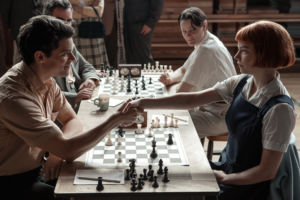
Stateman and Hoehn have been perfecting their Cutting Room 2.0 workflow since 2016, while working with writer/director Scott Frank, picture editor Michelle Tesoro, and composer Carlos Rafael Rivera on Netflix’s Godless series. In that pre-pandemic time, “we were set up in the cutting room with them. We were actually connected to their Avid Media Composer system via the NEXIS and, as soon as Michelle deemed a cut ‘pencils down,’ we were able to start immediately — viewing it and creating sound for it,” says Hoehn.
These days, the process is the same; it’s just happening remotely. For Netflix’s new series The Queen’s Gambit, director Frank reunited with Tesoro, Rivera, Stateman, and Hoehn. Using collaboration tools like Evercast, Zoom, Aspera, Resilio Sync, Source-Connect, and others, the sound team still had access to a scene or sequence as soon as Tesoro had a cut. They could send their designed and mixed tracks back to the editor just as fast as if they were in the editing suite with her. They could even have remote, real-time final mix playback sessions with the director, editor, music editor, composer, and producer even though they were in multiple and often distant locations. “The tools are really good at keeping continuity between the media between the various departments,” says Hoehn.
But this process takes more than tools. Stateman notes that they ask the team to be very meticulous with how they manage the Pro Tools sessions, how they manage the media, and how they manage the turnovers and the versions. Hoehn says, “A lot of that requires a very intense discipline to maintain the work that is being done, to be good at maintaining and conforming and chasing cuts so that your work is preserved. This way, when the picture changes you don’t have to redesign a whole sequence.”

But above all else, it’s the relationship that Stateman and Hoehn have with filmmakers Frank and Tesoro that makes this workflow possible. “We made developing trust with them a very important part of our relationship, because of that, we take part in the cut immediately adding value, context and depth to the story in terms of sound,” says Hoehn.
…because of that, we take part in the cut immediately adding value, context and depth to the story in terms of sound.
There are thousands of sound-related decisions to make and Stateman and Hoehn make the majority of those in the moment as they’re designing and mixing. This keeps the filmmakers from being overwhelmed by minutiae. The picture editor may make adjustments based on their tastes as well, and those tracks are added into the cut. The filmmakers can then judge the cut and the sound in context. If something stands out, or the filmmakers want to try a different approach, then there’s time to explore options. If the filmmakers don’t have a note about this sound or that, then those stay locked to the end. “It’s a rapid prototyping process that’s done at a high enough quality to be shaped as a final soundtrack. This rapid prototyping isn’t a proxy for the final; it is for all intent, the final,” says Stateman.
Since sound decisions are happening throughout editorial, the “final mix becomes very focused on other high-yield priorities, like ‘Is that music cue to low or a little too loud? and ‘Are we hearing enough punctuation from sound design or hyper detail from Foley?’ Those are the conversations we’re having in the final days after having spent many months just focused completely on the big picture,” says Hoehn.
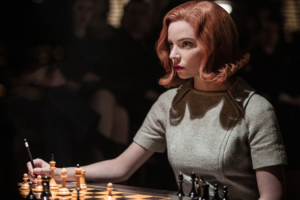
The benefits of Cutting Room 2.0 are evident in the fluid feel of The Queen’s Gambit. The series follows a young orphan, Beth Harmon (Anya Taylor-Joy), who becomes a Grand Master chess player. Pace, timing, and clarity are hallmarks of this show’s editing — for both picture and sound.
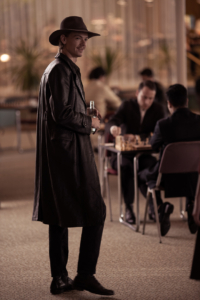
Some matches are fast-paced (and furious), like Beth’s speed chess matches against U.S. Chess Champion Benny Watts (Thomas Brodie-Sangster). First, in Ep. 5 “Fork,” there are the frustrating sets played one evening during a break in the U.S. Championship in Ohio. Beth is beaten by Benny time and again. The ticking clock, the definitive thumps of the pieces on the board, and the quick swishes as they’re swiped away create the music of her defeat. It’s easy to perceive Beth’s waning enthusiasm by the slowly-decreasing timing of the swishes and thumps set against the persistent ticking of the chess clock. You can almost feel Beth thinking more cautiously through her moves with each subsequent game.
Later, in Ep. 6 “Adjournment,” Beth gets redemption in another round of speed chess. Georgie Fame & The Blue Flames’ peppy and positive tune “Yeh, Yeh” plays as she beats Benny and both of his friends. The sounds of the chess pieces sliding across and striking the board, the woody click of pieces tapping together as one overtakes another, and the snap of the time clock marking the end of each move accompany the source track in a syncopated way. The quick picture cuts support the fast-paced action of the players’ back-and-forth exchanges. It’s more like watching tennis than chess because sound and picture together create a feeling of energy and anticipation.
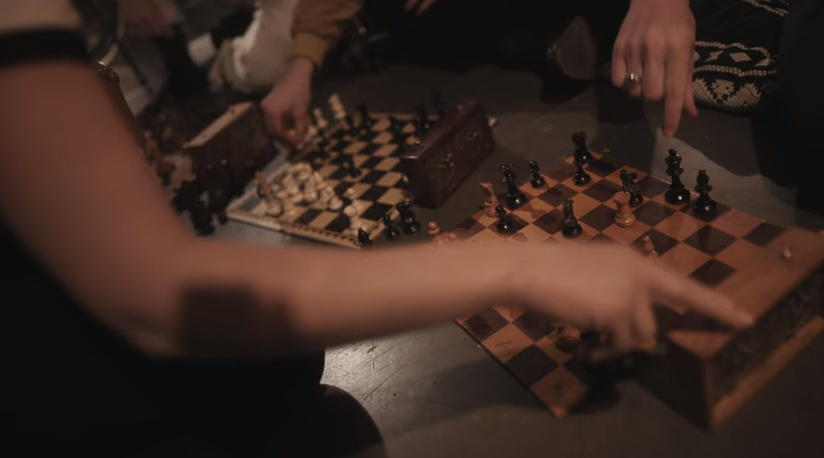
During the aforementioned Ohio Championship in Ep. 5, Beth and Benny play their way through match after match trying to reach the final round where they could square off against each other. Their respective matches are briefly shown in a series of panels that effectively condense three days of chess matches into one musical montage. 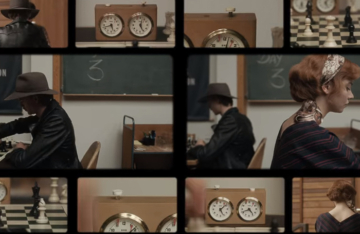 “You could play that scene with just the song “Classical Gas” but we played with these panels moving, and with the clocks ticking, the pieces moving on the board, and other sounds like breaths to create rhythms that would enhance the moment,” says Stateman. “The “Classical Gas” track alone would have been a great bed to work with, but then you have all of these moving visual parts and you take these fine sound details and use them to sharpen the audience’s focus and put their attention directly where you want it to be. It builds tension and excitement and it takes a board game like chess and makes it a gladiator match of intellect,” says Stateman.
“You could play that scene with just the song “Classical Gas” but we played with these panels moving, and with the clocks ticking, the pieces moving on the board, and other sounds like breaths to create rhythms that would enhance the moment,” says Stateman. “The “Classical Gas” track alone would have been a great bed to work with, but then you have all of these moving visual parts and you take these fine sound details and use them to sharpen the audience’s focus and put their attention directly where you want it to be. It builds tension and excitement and it takes a board game like chess and makes it a gladiator match of intellect,” says Stateman.
He adds, “The chess matches themselves were really a study in making an ancient board game into a modern strategy, gladiator domination-and-submission battle. This show isn’t teaching people to play chess — that’s why they mainly show the characters’ faces and only have quick cuts to the board when pieces are moved.
…we’re trying to take what we’ve learned about modern videogame viewership and apply those same stimuli to chess…
Instead, we’re trying to take what we’ve learned about modern videogame viewership and apply those same stimuli to chess to activate those impulses that people feel when they are watching a sport. And we’re using sound to activate those impulses that make people want to watch somebody else play a game.”
Clarity is also a feature of the soundtrack. Stateman and Hoehn have mastered the art of insinuating silence using precise Foley sounds, like playing the squeak of Beth’s shoe on the floor as she enters the screened-off “Top Boards” area where two highly-skilled players are competing. Even though the scene is scored with music, as Beth approaches the small crowd watching the game, you know it is pin-drop quiet just by that tiny, innocuous shoe squeak.

These details — like an actor’s scratch of pencil on paper as they log their moves, a protracted exhale of contemplation — are allowed to shine through the mix because the track is uncluttered. The Cutting Room 2.0 approach of rapid prototyping allows Stateman to focus on using sound to serve the story without over designing a scene. “I wish we could talk about how hard we worked but I can’t. We like to work fast, and efficiently, and create priorities so we spend our time on the highest yielding story moments,” he says.
During the mix, they didn’t have to wade through tons of tracks to find the best sonic details. Those decisions were happening during editorial. Stateman explains, “A lot of mixing is dealing with masking. The reason we rapidly prototype is so that everyone can see who is contributing what, and the best idea wins. So from the beginning, we removed this masking effect.”
You synchronize your mix move to that camera move so that everything feels very deliberate.
Since Hoehn doesn’t have to decide what sounds should carry a scene during the mix, he can spend more time finding the best moments to make mix transitions. “When you need to make a mix move and lower the backgrounds to favor the music or you need to create some sort of dramatic effect so that the focus is on the character, you may use a camera push-in on the character’s face as your transition. You synchronize your mix move to that camera move so that everything feels very deliberate. It’s not random. It feels like as the camera is moving in, we’re creating a moment of change in the mix. And we’re constantly looking for opportunities like that, making things feel like they are meant to be there and deliberate, the audience very much appreciates that. They can make sense of it,” explains Hoehn.
Stateman concludes, “When you really get down to the mindset of what’s important and what you want the audience to experience in the moment, then the mix is easy because there’s very little clutter. Together we prototype the soundtrack as early as possible so everyone understands — the editor, the director, and the composer. It’s so much faster. It’s much more interesting and enjoyable to then have the time to focus creative intention on the remaining new ideas.”





